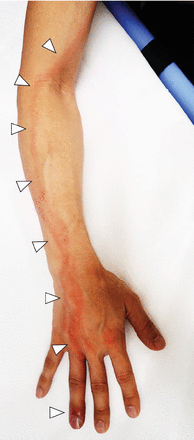Lymphangitis
content of this page
1- Introduction
2- Anatomical Overview
3- Causes
4- Treatment
Introduction

Anatomical Overview
Lymphangitis and lymphadenitis are secondary inflammations of lymphatic vessels and lymph nodes, respectively. These conditions may occur when the lymphoid system is involved in chemical or bacterial transport after severe injury or infection. The lymphatic vessels, not normally evident, may become apparent as red streaks in the skin, and the nodes become painfully enlarged. This condition is potentially dangerous because the uncontained infection may lead to septicemia (blood poisoning). Lymphedema, a localized type of edema, occurs when lymph does not drain from an area of the body. For instance, if cancerous lymph nodes are surgically removed from the axilla (compartment superior to the armpit), lymphedema of the limb may occur. Solid cell growths may permeate lymphatic vessels and form minute cellular emboli (plugs), which may break free and pass to regional lymph nodes. In this way, further lymphogenous spread to other tissues and organs may occur.

Causes
Bacterial Infections: The most frequent cause of lymphangitis is the spread of bacteria from a local infection site, such as a wound, cut, or insect bite, into the lymphatic vessels. Common bacterial pathogens associated with lymphangitis include Streptococcus and Staphylococcus species.
Cellulitis: Cellulitis is a bacterial skin infection that can spread to the lymphatic vessels, leading to lymphangitis.
Strep Throat: Streptococcal infections, including strep throat, can sometimes lead to lymphangitis if the infection spreads beyond the throat area.
Infections in Extremities: Infections in the arms or legs, such as those caused by injuries, surgical wounds, or foreign bodies, can lead to lymphangitis in the affected limb.
Animal Bites: Bacterial infections transmitted through animal bites, particularly from cats, dogs, or other animals, can lead to lymphangitis if the bacteria enter the lymphatic vessels.
Systemic Infections: In some cases, systemic infections, such as septicemia (bloodstream infection), may cause lymphangitis as the infection spreads throughout the body.
Lymphatic Obstruction: Rarely, lymphangitis can occur due to lymphatic obstruction, which may be caused by conditions like lymphedema, filariasis (a parasitic infection), or certain types of cancer.
Treatment
Antibiotics: Since lymphangitis is commonly caused by bacterial infections, antibiotics are usually prescribed to target the specific bacteria responsible for the infection. The choice of antibiotics depends on the suspected or identified pathogen and its sensitivity to antibiotics. Oral antibiotics are typically prescribed for mild cases, while severe cases may require intravenous antibiotics administered in a hospital setting.
Pain Relief: Pain and discomfort associated with lymphangitis can be managed with over-the-counter pain relievers such as acetaminophen (Tylenol) or nonsteroidal anti-inflammatory drugs (NSAIDs) like ibuprofen (Advil, Motrin) or naproxen (Aleve).
Rest and Elevation: Resting the affected limb and elevating it above the level of the heart can help reduce swelling and promote lymphatic drainage.
Warm Compresses: Applying warm compresses or soaking the affected area in warm water can help alleviate pain and promote circulation, which may aid in resolving the infection.
Hydration: Drinking plenty of fluids helps maintain hydration and supports the body’s immune response to the infection.
Wound Care: Proper care of any underlying wounds or skin lesions is essential to prevent further bacterial entry and promote healing.
Follow-up Care: Regular follow-up with a healthcare provider is important to monitor the progression of the infection, ensure appropriate response to treatment, and make adjustments to the treatment plan if necessary.